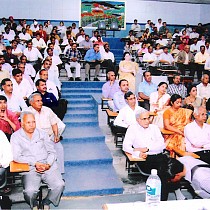INFLUENCE OF FOOD PLANTS ON THE GROWTH AND DEVELOPMENT OF THE GRASSHOPPER, HIEROGLYPHUS NIGROREPLETUS BOLIVAR
Department of Entomology, Rajasthan College of Agriculture, MPUAT, Udaipur, INDIA
PRADEEP SINGH RATHORE AND R. SWAMINATHAN
Investigations on the effect of different food plants on growth and development of the common grasshopper, Hieroglyphus nigrorepletus Bolivar were carried out in the Department of Entomology, Rajasthan College of Agriculture, Udaipur over two kharif (monsoon) crop seasons (2007 and 2008). Growth and development was best on maize followed by sorghum; resultantly, the development period manifested by hopper duration was the lowest on these two host plants (21.5 to 22.0 days on maize; 22.75 to 23.5 days on sorghum); the survival ranged from 97.50 to 100 per cent; and the growth index was the highest during both years on maize (4.54 and 4.65), followed by that on sorghum (4.26 and 4.40). Plants of Graminae (Poaceae) were more preferred than dicots; however, mixed food indicated a moderate preference. The food utilization indices, efficiency of conversion of ingested food (ECI) and the approximate digestibility (AD) were the highest when the grasshopper (H. nigrorepletus) was fed on maize, though the efficiency of conversion of digested food into body substances (ECD) was the maximum for sorghum and Cynodon dactylon.


